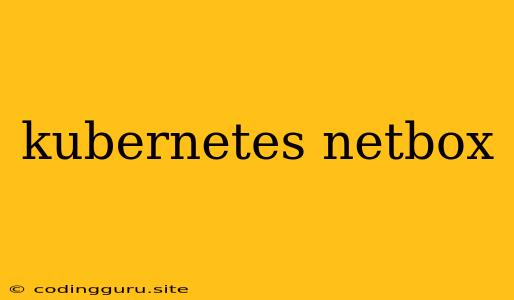Managing Your Kubernetes Infrastructure with NetBox
In the world of modern cloud-native applications, Kubernetes has become the de-facto standard for orchestrating and managing containerized workloads. But with the rise of Kubernetes deployments, managing the underlying network infrastructure becomes increasingly complex. That's where NetBox comes in.
What is NetBox?
NetBox is an open-source data center infrastructure management (DCIM) platform. It provides a centralized repository for storing and organizing information about your network devices, physical and virtual infrastructure, and IP addresses.
Why Use NetBox with Kubernetes?
While Kubernetes itself offers powerful features for managing containerized applications, it doesn't inherently provide a comprehensive way to manage the underlying physical and virtual infrastructure. Using NetBox alongside Kubernetes offers several benefits:
1. Improved Network Visibility and Management:
NetBox provides a comprehensive view of your network infrastructure, including devices, interfaces, VLANs, and IP addresses. This information is critical for understanding and troubleshooting network connectivity issues within your Kubernetes cluster.
2. Automated IP Address Management:
NetBox's built-in IP address management (IPAM) system allows you to easily allocate and track IP addresses for your Kubernetes nodes, pods, and services. This automation helps prevent IP address conflicts and ensures efficient utilization of available IP space.
3. Infrastructure Documentation and Reporting:
NetBox provides a central repository for all your infrastructure documentation. This ensures that all team members have access to up-to-date information about your Kubernetes cluster's physical and virtual components. NetBox also offers robust reporting capabilities, allowing you to generate detailed reports on your network infrastructure.
4. Integration with Kubernetes Tools:
NetBox integrates seamlessly with various Kubernetes tools and technologies, such as:
* **Kubernetes API:** NetBox can directly access information from the Kubernetes API, providing visibility into your pods, services, and deployments.
* **Network Policy Enforcement:** NetBox can be used to enforce network policies within your Kubernetes cluster, restricting communication between pods and services based on specific IP addresses or other criteria.
* **Container Network Interface (CNI):** NetBox can be used to configure and manage the CNI plugins responsible for networking within your Kubernetes cluster.
How to Use NetBox with Kubernetes:
Here are some practical tips for using NetBox to manage your Kubernetes infrastructure:
1. Define Your Network Topology in NetBox:
Start by documenting your physical and virtual network topology within NetBox. This includes devices like switches, routers, and firewalls, as well as virtual infrastructure components like VLANs and subnets.
2. Create IP Address Ranges for Kubernetes:
Allocate dedicated IP address ranges for your Kubernetes nodes, pods, and services within NetBox's IPAM system. This ensures that your Kubernetes deployments have sufficient IP addresses to operate.
3. Integrate NetBox with Your Kubernetes Cluster:
Use NetBox's API or third-party tools to integrate NetBox with your Kubernetes cluster. This allows you to automatically provision network resources for new pods and services.
4. Utilize NetBox for Network Policy Enforcement:
Use NetBox to define and enforce network policies within your Kubernetes cluster. This can help to improve security and limit the impact of potential network failures.
5. Implement Automated Reporting and Monitoring:
Leverage NetBox's reporting capabilities to track network performance and identify potential issues within your Kubernetes cluster.
Example: Integrating NetBox with Kubernetes for IP Address Management
Imagine you have a new Kubernetes cluster that requires a range of IP addresses for its nodes and pods. Using NetBox's IPAM system, you can easily allocate a dedicated subnet for your cluster.
- Create a new IP address range within NetBox.
- Assign this range to your Kubernetes cluster within NetBox's data model.
- Configure your Kubernetes cluster to automatically request IP addresses from NetBox.
This process ensures that your Kubernetes cluster can easily obtain the IP addresses it needs while maintaining a centralized and organized view of your network infrastructure.
Conclusion:
NetBox provides a valuable platform for managing the network infrastructure behind your Kubernetes deployments. By integrating NetBox with Kubernetes, you can achieve improved network visibility, automate IP address management, enforce security policies, and streamline your infrastructure management workflow. This ultimately leads to a more robust and efficient Kubernetes deployment.
